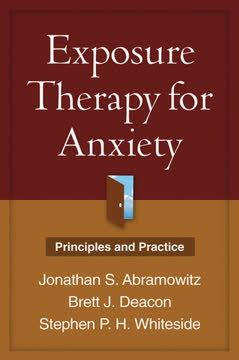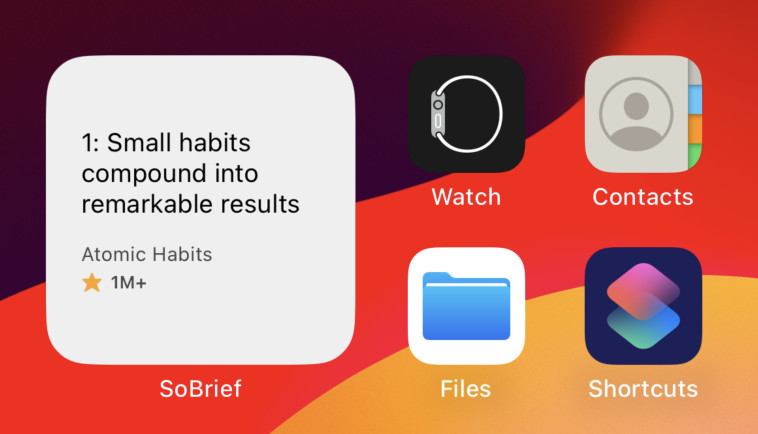Key Takeaways
1. Anxiety is a Misperception of Danger, Maintained by Avoidance
The problem for anxious patients is that such individuals (mis)perceive a serious threat where the risk of true danger is actually low.
Normal vs. Abnormal. Anxiety is a natural, adaptive "fight-or-flight" response to perceived threats, crucial for survival. However, clinical anxiety arises when this response is triggered unnecessarily, misinterpreting safe situations as dangerous. This misperception creates a vicious cycle where anxious feelings lead to more threat perception.
Avoidance perpetuates fear. When faced with perceived danger, individuals naturally avoid or escape the feared stimulus. While this provides short-term relief, it prevents them from learning that the stimulus is objectively safe. This lack of corrective learning reinforces the erroneous belief that the feared situation is dangerous, perpetuating the anxiety.
Maladaptive beliefs. The persistence of anxiety is rooted in several maladaptive beliefs:
- Probability overestimation: Exaggerating the likelihood of negative consequences (e.g., heart attack from panic).
- Cost overestimation: Believing feared outcomes are catastrophic (e.g., embarrassment is unbearable).
- Intolerance of uncertainty: Inability to accept even remote possibilities of danger.
- Low coping self-efficacy: Underestimating one's ability to manage threats or anxiety itself.
- Biased information processing: Selective attention to threats and selective memory of negative events.
2. Exposure Therapy: Confronting Fear to Rewire the Brain
If these criteria are met, then emotional change will occur (Foa & Kozak, 1986).
Core mechanism. Exposure therapy is a direct, cognitive-behavioral approach that involves repeated and prolonged contact with a feared stimulus. The goal is to weaken the association between anxiety and the objectively non-dangerous stimulus, teaching the person that the situation is not as dangerous as previously thought, and that anxiety itself is not harmful. This process is termed "emotional processing."
Safety learning. Rather than "unlearning" fear, exposure therapy facilitates "safety learning." New safety information actively competes with older, fearful memories. By confronting feared stimuli in the absence of actual threat or dreaded consequences, the brain cultivates and strengthens a new behavioral repertoire, demonstrating that the perceived danger is exaggerated.
Disrupting the cycle. Exposure therapy directly targets the vicious cycle of anxiety by:
- Disconfirming maladaptive beliefs: Patients learn that feared outcomes are unlikely or manageable.
- Promoting habituation: Anxiety naturally subsides with prolonged exposure, even without safety behaviors.
- Building coping skills: Patients gain confidence in their ability to manage distress.
This approach helps patients replace maladaptive patterns of thinking, feeling, and acting with healthier ones.
3. Evidence-Based: Exposure is the Gold Standard for Anxiety
In fact, the majority of well-established treatments for anxiety and stress disorders include exposure exercises.
Scientific rigor. Exposure therapy is one of the most rigorously evaluated psychological interventions for anxiety disorders. Numerous randomized controlled trials (RCTs) and meta-analyses consistently demonstrate its efficacy and effectiveness across a wide range of anxiety-related problems.
Superior outcomes. Research shows that exposure-based treatments are:
- More effective than no treatment or placebo.
- Often outperform non-exposure-based interventions.
- Produce large effect sizes (ESs) for symptom reduction.
- Lead to sustained improvements, often superior to medication alone in the long term.
Broad applicability. Exposure therapy is a "well-established treatment" for:
- Specific Phobias (ES = 1.05)
- Panic Disorder (ES = 1.55)
- Obsessive-Compulsive Disorder (ES = 1.46)
- Hypochondriasis/Health Anxiety (ES = 2.05)
- Posttraumatic Stress Disorder (ES = 1.89)
- Social Phobia (ES = 1.06)
- Generalized Anxiety Disorder (ES = 0.82)
- Childhood Anxiety Disorders (ES = 0.86)
These robust findings underscore its position as a first-line, evidence-based intervention.
4. Functional Assessment: The Blueprint for Personalized Exposure
The functional relations among the specific situations, stimuli, cognitions, and responses—over and above a diagnosis—are most critical when planning and implementing effective exposure therapy.
Beyond diagnosis. Effective exposure therapy requires a deep, individualized understanding of the patient's anxiety, going beyond a mere diagnostic label. Functional assessment, or behavioral analysis, identifies the unique interplay of triggers, responses, and maintaining factors for each individual. This idiographic approach is crucial because anxiety manifests diversely, even within the same diagnostic category.
Key assessment components: A thorough functional assessment gathers information on:
- Fear Cues: What specific external situations, objects, internal bodily sensations, or intrusive thoughts/images/doubts trigger anxiety?
- Feared Consequences: What catastrophic outcomes does the patient believe will happen if they confront the fear (e.g., physical harm, loss of control, social rejection, unending anxiety)? The "downward-arrow technique" helps uncover these core fears.
- Safety Behaviors: What actions (avoidance, checking, reassurance-seeking, rituals, safety signals) does the patient use to reduce anxiety or prevent feared consequences?
Ongoing process. Functional assessment is not a one-time event but an ongoing process throughout therapy. Continuous information gathering and self-monitoring help refine the conceptualization and adapt the treatment plan as the patient progresses, ensuring the exposure remains targeted and effective.
5. The Exposure Hierarchy: A Gradual Path to Fear Mastery
As I like to tell people, you must invest anxiety now in order to have a calmer future.
Therapeutic roadmap. The fear hierarchy is a collaboratively developed list of feared stimuli, ranked from least to most anxiety-provoking (0-100 SUDS - Subjective Units of Discomfort Scale). It serves as the patient's personalized roadmap for confronting fears, ensuring a structured and manageable progression through treatment.
Strategic design. Hierarchy items must closely match the specific elements of the patient's fear, including situational, cognitive, and physiological aspects. This ensures that the exposure directly challenges the patient's maladaptive beliefs.
- Specificity: Items should be detailed enough to guide the task but flexible for on-the-spot adjustments.
- Targeting feared consequences: Each item is an "experiment" to test specific catastrophic predictions.
- Gradual progression: Typically, patients start with moderately distressing items and gradually work towards their worst fears, building confidence along the way.
The "worst fear." It is crucial to include and confront the patient's most fundamental fears on the hierarchy. Failure to do so can leave residual beliefs that some aspects of their fear are valid, hindering complete recovery. The therapist acts as a coach, providing support and encouragement, but emphasizing the patient's active role in confronting distress.
6. Response Prevention: Eliminating Safety Behaviors is Crucial
Response prevention means that, again with my help, you’ll practice not using maladaptive safety behaviors to reduce your anxiety.
Breaking the cycle. Safety behaviors, whether overt rituals, subtle mental maneuvers, or reliance on safety signals, are central to maintaining anxiety. They provide temporary relief but prevent corrective learning, reinforcing the belief that these behaviors are necessary to avert disaster. Response prevention is the deliberate act of refraining from these behaviors.
Types of safety behaviors:
- Passive avoidance: Completely staying away from feared situations.
- Checking/Reassurance seeking: Repeatedly verifying safety or seeking verbal comfort from others.
- Compulsive rituals: Repetitive actions (mental or physical) to neutralize thoughts or prevent harm.
- Covert rituals: Subtle mental acts like thought suppression, analyzing, or distracting.
- Safety signals: Relying on objects or people (e.g., cell phone, "safe person") for a sense of security.
Strategic implementation. Response prevention should ideally be implemented "cold turkey" for maximum effect, but a gradual approach may be necessary for highly resistant behaviors or overwhelming fears. The therapist must clearly explain why these behaviors are counterproductive, emphasizing that discontinuing them allows the patient to learn that feared outcomes are unlikely and anxiety is manageable. Family members should also be educated to avoid accommodating these behaviors.
7. Tailoring Exposure: Situational, Imaginal, and Interoceptive
The successful application of exposure therapy requires a mastery of multiple skills.
Situational (In Vivo) Exposure: This involves direct, real-life confrontation with feared objects, situations, or places. It's highly effective for tangible fears like animals, heights, or social interactions.
- Examples: Visiting higher floors of a building, interacting with strangers, touching "contaminated" items.
- Key: Must match the specific fear and be prolonged until anxiety subsides.
Imaginal Exposure: Used for fears triggered by mental events like intrusive thoughts, images, doubts, or traumatic memories.
- Primary: Directly confronting repugnant thoughts/images (e.g., violent obsessions, traumatic flashbacks).
- Secondary: Visualizing feared consequences during or after situational exposure (e.g., imagining a house fire after leaving an appliance on).
- Preliminary: Imagining a feared stimulus as a step towards actual confrontation (less common as a primary method).
- Method: Often involves writing scripts or recording narratives to be replayed repeatedly.
Interoceptive Exposure: Targets fears of internal bodily sensations (e.g., racing heart, dizziness) often associated with panic attacks.
- Method: Intentionally re-creating feared sensations (e.g., running in place, hyperventilating, spinning in a chair).
- Goal: To learn that these sensations are harmless, temporary, and do not lead to catastrophic outcomes.
- Integration: Can be combined with situational exposure (e.g., hyperventilating in a crowded mall).
8. Complexities & Comorbidity: Adapt, Don't Abandon Exposure
When initial exposure sessions are unsuccessful, it may be tempting to consider the patient “resistant to exposure” and look for alternative paradigms to explain and treat his or her problem.
Adhere to fundamentals. Complex cases, often involving multiple diagnoses or complicating factors, are the norm. Instead of abandoning exposure, therapists should revisit the functional assessment and ensure the exposure plan is precisely tailored to the patient's unique fears and maintaining factors. Unsuccessful sessions often point to issues in implementation, not the method itself.
Prioritize and connect symptoms. When multiple problems exist, prioritize treatment goals based on severity, impact on functioning, and therapy interference. Understanding the connections between symptoms (e.g., panic attacks triggered by obsessional thoughts) can lead to a single, integrated exposure plan.
- Safety first: Address immediate risks like suicidal ideation or substance abuse.
- Therapy-interfering behaviors: Tackle non-adherence, frequent cancellations, or distrust.
- Target root causes: Focus on symptoms that drive other problems (e.g., treating panic to alleviate secondary depression).
Collaborate and adapt. Complex cases may require collaboration with other professionals (e.g., physicians, family therapists). Exposure can be adapted for coexisting medical conditions (with medical clearance), depression (often secondary to anxiety), and even some personality disorders, though conditions like active psychosis or uncontrolled mania require stabilization first.
9. Involving Loved Ones: Aiding or Abetting Anxiety?
Family members often become intricately involved with their loved one’s anxiety symptoms.
Symptom accommodation. Loved ones, with the best intentions, often inadvertently maintain anxiety symptoms by accommodating avoidance and safety behaviors. This can range from subtle actions (e.g., avoiding certain topics) to extreme measures (e.g., cleaning for a contamination-phobic adult child). This accommodation prevents the anxious individual from confronting fears and learning corrective information.
Relationship conflict. Anxiety disorders can also create significant relationship distress, leading to increased arguments, criticism, and reduced positive interactions. Poor communication and problem-solving skills within a couple can exacerbate anxiety, while anxiety symptoms (e.g., social phobia, emotional numbing in PTSD) can strain intimacy and shared activities.
Strategic involvement. Involving significant others in treatment is crucial:
- Psychoeducation: Educate family members about the anxiety model and how accommodation perpetuates symptoms, fostering empathy and reducing blame.
- Partner-assisted exposure: Train a supportive partner as an "exposure coach" to help the patient confront fears and resist safety behaviors, providing encouragement and gentle reminders.
- Eliminating accommodation: Work collaboratively with the family to identify and gradually reduce accommodating behaviors, shifting focus to healthier ways of expressing care and support.
10. Medication: Augmenting Learning, Not Just Dampening Symptoms
The emerging literature on the use of DCS to facilitate fear extinction during exposure is promising, yet additional research is necessary before this approach is ready for widespread use.
Traditional pharmacotherapy. While medications like SSRIs and benzodiazepines (BZs) are effective for anxiety, research shows mixed results when combined with exposure therapy. BZs, especially when used "as needed," can interfere with exposure by dampening physiological arousal, preventing fear activation, and leading patients to attribute improvement to the drug rather than their own efforts.
Integrated rationale. When combining treatments, it's vital to convey an integrated rationale: biological factors may increase vulnerability, but psychological processes (maladaptive beliefs, safety behaviors) maintain anxiety. Medication can provide symptom relief, but exposure directly targets and modifies these problematic cognitive and behavioral responses.
Pharmacological enhancers. A new frontier involves "cognitive enhancers" like D-cycloserine (DCS), which don't reduce anxiety directly but enhance the brain's fear extinction learning during exposure.
- DCS: Shown to accelerate fear reduction and improve long-term outcomes in studies for phobias, OCD, and social anxiety.
- Mechanism: Facilitates neural learning processes, making exposure more efficient.
This represents a paradigm shift, focusing on enhancing psychotherapy's effects rather than solely correcting biological imbalances.
11. Sustaining Gains: Become Your Own Exposure Therapist
Exposure therapy is, by design, a brief treatment in which patients are encouraged to develop the skills necessary to conduct the therapy independently.
Empowering autonomy. The ultimate goal of exposure therapy is to equip patients with the skills to manage anxiety independently, becoming their own therapists. This involves a gradual transfer of responsibility from the clinician to the patient, fostering self-efficacy and long-term resilience.
Markers of completion: Treatment is considered complete when:
- Hierarchy completion: Patient has successfully confronted their highest feared items.
- Belief correction: Maladaptive threat beliefs are corrected, and uncertainty is tolerated.
- Safety behavior elimination: All safety behaviors are discontinued.
- Improved functioning: Significant enhancement in quality of life and daily activities.
Relapse prevention plan: To maintain gains, patients need a proactive strategy:
- Spaced sessions: Gradually reduce therapy frequency to consolidate learning in varied contexts.
- Self-directed practice: Continue planned and "lifestyle" exposures, using monitoring forms as needed.
- Anticipate triggers: Identify high-risk situations (stressful life events, medication discontinuation) that might cause a lapse.
- Lapse vs. relapse: Understand that temporary symptom re-emergence (lapse) is normal and not a full return of the disorder.
- Action plan: Have a clear strategy for responding to lapses by re-engaging therapy skills and, if necessary, contacting the therapist.
12. Exposure is Safe, Ethical, and Highly Effective
Indeed, this treatment may have more scientific support than any other psychotherapy of any kind, for any problem.
Misconceptions challenged. Despite overwhelming evidence, exposure therapy is underutilized due to common therapist misconceptions:
- High dropout rates: Research shows dropout rates are comparable to or lower than other treatments.
- Worsening symptoms: Temporary exacerbation is uncommon and does not predict poorer outcomes.
- Patient dislike: Patients often find it highly useful and acceptable, despite temporary discomfort.
- Legal risks: No documented litigation related to exposure therapy, indicating its acceptable safety profile.
Minimizing risks. Ethical practice dictates minimizing harm. Exposure is generally safe because:
- Informed consent: Ongoing, explicit consent is obtained for each exposure task.
- Acceptable risk: Tasks involve risks no greater than those encountered in everyday life (e.g., driving, public interaction).
- Therapist competency: Proper training and supervision ensure safe and effective delivery.
- Therapist self-care: Managing one's own emotional response to patient distress is crucial.
Ethical boundaries. While exposure may involve "boundary crossings" (e.g., out-of-office sessions, active engagement), these are clinically appropriate and necessary for effective treatment, not unethical "slippery slopes." The therapeutic value of crossing a boundary must always outweigh potential risks. The vast disconnect between exposure's proven efficacy and its low utilization is a significant concern, highlighting the need for greater education and adoption of this powerful treatment.
Last updated:
Review Summary
Exposure Therapy for Anxiety receives high praise from readers, with an average rating of 4.40/5. Reviewers find it an invaluable resource for learning and implementing exposure therapy techniques. The book is commended for its comprehensive coverage of anxiety treatments, step-by-step guidance, and ethical considerations. Readers appreciate its evidence-based approach and practical tips for various anxiety disorders. Some consider it essential reading for therapists treating anxiety. The book's clarity and effectiveness in preparing therapists for exposure-based CBT are highlighted. Overall, it's regarded as an indispensable manual for anxiety treatment.
Similar Books
Download PDF
Download EPUB
.epub digital book format is ideal for reading ebooks on phones, tablets, and e-readers.










